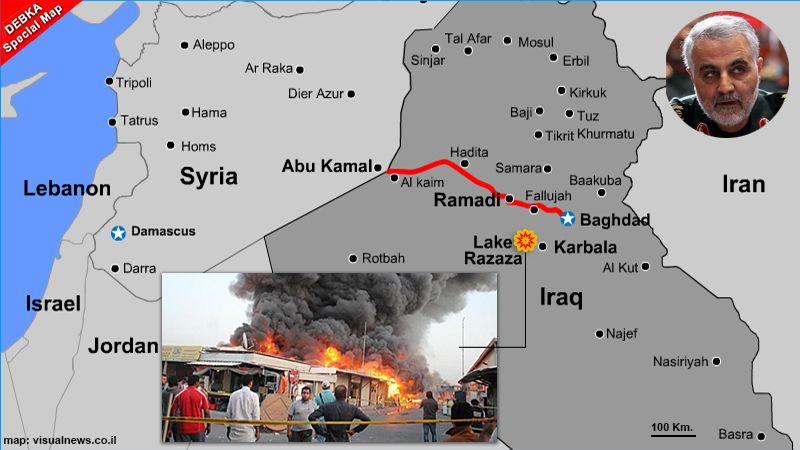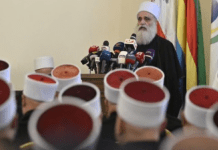The Great Middle Eastern War of 2019
حرب الشرق الأوسط الكبرى لسنة 2019
Maj. Nadav Ben Hour, IDF and Michael Eisenstadt/The Washington Institute/American Interest/August 22/2018
Far from simply replaying the 2006 Lebanon war, the next conflict on Israel’s northern frontier will likely involve many more actors on multiple fronts, raising unprecedented challenges for escalation management.
Growing tensions on Israel’s northern border have raised concerns about yet another Israel-Hezbollah confrontation or a war between Israel and Iran in Syria. Such a war may not be limited to the original participants, but could involve an array of Shi’a militias and even the Assad regime, and could span the region—thereby affecting vital U.S. interests.
Two factors are driving these tensions: efforts by Hezbollah and Syria—with Iran’s help—to produce highly accurate missiles in Lebanon and Syria that could cripple Israel’s critical infrastructure and make life there intolerable; and Iran’s efforts to transform Syria into a springboard for military operations against Israel and a platform for projecting power in the Levant. Iran, however, while pursuing an anti-status quo agenda that has often brought it into conflict with Israel and the United States, has shown that it seeks to avoid conventional wars and consequent heavy losses to its own forces. Instead, it relies on proxy operations, terrorism, and non-lethal shaping activities. Yet it has occasionally been willing to venture high-risk activities that entail a potential for escalation. (Example: Iranian forces in Syria launched an explosives-laden UAV into Israeli airspace in February; it was shot down, but the incident sparked a round of clashes.)
Israel also seems intent on avoiding war, though its actions show that it is willing to accept the risk of escalation to counter these emerging threats. Indeed, since 2013 it has carried out more than 130 strikes in Syria on arms shipments destined for Hezbollah, and since late 2017 it has expanded this “campaign between the wars” to target Iranian military facilities in Syria—without, thus far, sparking a wider confrontation.
Complacency is, however, unwarranted. The two major Arab-Israeli confrontations of the recent past (Lebanon 2006, Gaza 2014) resulted from unintended escalation. The emerging dynamic between Israel, Iran, and the “axis of resistance” is a formula for a third major “accident,” and so deserves careful analysis.
MULTIPLE ACTORS, FRONTS, AND DOMAINS
The potential for yet another war—one of unprecedented scope and complexity—is an outcome of the Syrian civil war, which has enabled Iran to build a military infrastructure in Syria and to deploy its Shi’a “foreign legion” to Israel’s borders. War is now possible on multiple fronts and in far-flung theaters, fought on land, in the air, at sea, and in information and cyber domains by fighters from Hezbollah, Iran, Syria, Iraq, Afghanistan, Pakistan, and even Yemen. The widened scope of a possible war will create new military options for Iran and Hezbollah, and stretch Israeli capabilities to their limits.
Hezbollah Secretary General Hassan Nasrallah said as much, though perhaps with some exaggeration, when he warned in June 2017 that “if an Israeli war is launched against Syria or Lebanon it is not known that the fighting will remain Lebanese-Israeli, or Syrian-Israeli,” and “this could open the way for thousands, even hundreds of thousands of fighters from all over the Arab and Islamic world to participate.” Likewise, IRGC Commander Mohammad Ali Jafari stated in November 2017 that, “The fate of the resistance front is interwoven and they all stand united, and if Israel attacks a part of it, the other component of the front will help it.”
Such a war is most likely to occur as a result of unintended escalation, after another Iranian action against Israel from Syria, or after an Israeli strike in Lebanon or Syria (for example, against missile production facilities). It could start as a result of a U.S. and/or Israeli strike on Iran’s nuclear program. It might even come about as a result of a conflict that starts in the Gulf but that reaches Israel’s borders—perhaps as a result of Iranian diversionary moves (much as Saddam Hussein tried in 1991 to derail the U.S. military campaign to expel Iraqi forces from Kuwait by launching missiles at Israel).
A new northern war could resemble one of several scenarios:
Lebanon War Plus. A war between Israel and Hezbollah in Lebanon, in which Iranians, thousands of foreign Shi’a fighters, and even Hamas (which has established a limited military presence in southern Lebanon) also participate. The Syrian front remains relatively quiet, with Israel acting there on a limited basis to interdict the movement of fighters and capabilities into Lebanon.
War in Syria. A war between Israeli and Iranian forces, Shi’a militias (including Hezbollah fighters), and perhaps even elements of the Syrian military, fought on Syrian territory. The Lebanese front remains relatively quiet. Should Syrian ground forces get drawn into combat, however, Russia might intervene to protect its client.
A Two-Front War. A war in Lebanon and Syria between Israeli and Iranian troops, Hezbollah, Shi’a militias, and perhaps even elements of the Syrian military, in which both sides treat Lebanon and Syria as a single, unified theater of operations.
All three of these scenarios entail a potential for escalation or spillover into secondary fronts or theaters, and the involvement of additional actors:
Additional Fronts/Theaters. A war in Lebanon and/or Syria might prompt: attacks on Israel from Gaza, unrest in the West Bank, or terrorist attacks in Israel; Houthi attacks on Israeli interests (such as Israeli maritime traffic in the Bab al-Mandeb Strait), or Israeli strikes on Houthi targets in Yemen; missile attacks on Israel by Shi’a militias in Iraq, and Israeli counterstrikes. Some of these militias have already warned that the latter could trigger attacks on U.S. personnel in Iraq.
Israel vs. Iran. During fighting in Syria or Lebanon, Israel attacks Iran to strike a blow against the central pillar of the enemy coalition, and to thereby influence the course of the war. Alternatively, Iran augments attacks on Israel from Syria or Lebanon with attacks from its own territory, perhaps after suffering heavy losses in Syria. These could take the form of air or missile strikes and/or destructive cyberattacks on military targets and critical infrastructure.
A Regional War? A low-probability/high-impact scenario in which a conflict in the Levant morphs into a regional war involving Saudi Arabia and perhaps the United Arab Emirates as well. Israel responds to attacks on its critical infrastructure with air strikes or cyberattacks on Iran’s oil industry or even its nuclear facilities—with the encouragement and perhaps logistical assistance of Gulf Arab states. Iran retaliates against Israel, but also conducts missile strikes, sabotage, or cyberattacks on Arab oil facilities across the Gulf, leading to escalation there, and perhaps even military intervention by the United States.
CAMPAIGN DESIGN CONSIDERATIONS
For Israel, planning for and fighting the next northern war will entail unprecedented challenges, due to uncertainties regarding the number of actors involved, the potential for combat on multiple fronts, theaters, and domains (including cyber), and the role of the great powers. Moreover, because the military capabilities of both sides and the geopolitical environment are rapidly evolving, and because Iran began its entrenchment in Syria only recently, the character of a future war will be greatly influenced by its timing. A war in 2019 might be very different from a war in 2025.
Despite these uncertainties, recent experience and current trends permit several generalizations. Israel’s next northern war will be far more wide-ranging than prior conflicts. Israel may start with an intense air campaign to counter the threat of enemy rocket and missile forces and militias, but effectively dealing with this threat will require large-scale ground operations. Israel’s enemies will not be satisfied only with launching rockets and missiles at Israeli military facilities, population centers, and critical infrastructure, but they will try to use ground forces to infiltrate Israeli lines and to capture Israeli villages and small military outposts. They will also likely employ cyber warfare in support of conventional military operations (for instance, to disrupt Israeli missile defenses), and perhaps against critical infrastructure, to achieve strategic effects.
In past conflicts with Hezbollah, Israel focused on the organization’s military forces, its leadership, military specialists, and elements of the Lebanese infrastructure that facilitated its operations. In the next northern war, the dilemma of whether to prioritize action against immediate threats or enemy centers of gravity and critical enablers will be acute; substantial effort needs to be invested in identifying centers of gravity that can be targeted to hasten war termination on favorable terms.
Russia is a key actor in Syria and could be a key factor in a future war: Will Moscow stand aside, or will it constrain Israel’s ability to strike pro-regime forces in Syria, to prevent the unraveling of the Assad regime’s post-2015 civil war gains? And will Washington remain militarily uninvolved—beyond perhaps augmenting Israeli missile defenses—or will it play a more active role, seeing this as an opportunity to strike a blow against Iran, and thereby advance its goal of undermining the latter’s influence in the region? Depending on how events play out, Israel could face a disquieting possibility: Russian efforts to thwart its use of decisive force, U.S. reticence, and ineffectual great power diplomacy could prevent Israel from achieving its full military aims—not entirely unlike the denouement of the October 1973 war. That could ensure a protracted war, and perhaps a war that ends without Israel fulfilling its aims.
CHALLENGES OF COMPLEXITY
The next northern war will require new operational concepts and a rethinking of Israel’s “way of war,” especially its approach to attaining military decision via defeat mechanisms tailored to its adversaries. The challenge for planners is great because they are dealing with a complex emerging threat consisting of many actors, operating on multiple fronts, with no single, well-defined center of gravity. In addition, there will be many other factors that Israeli military planners will have to consider when grappling with this complex operational environment:
Ends, Ways, and Means. Israel’s war aims would likely be shaped by how a war begins and its geopolitical context. Would Israel aim to degrade enemy forces and to demoralize them? Disrupt the cohesion of the axis of resistance? Discredit the enemy’s “resistance doctrine”? Destabilize Syria and/or Iran? Or simply reestablish deterrence and bring about a prolonged period of quiet? How many of these goals are attainable? Should Israel focus on Hezbollah and Nasrallah? On Lebanese infrastructure that facilitates Hezbollah’s activities? On Iran and IRGC head Soleimani? On the Shi’a militias? Or on the Assad regime? How much emphasis should be placed on targeting the enemy’s field forces, military infrastructure, leadership, and motivation/morale, and how should Israel prioritize and phase these efforts? Finally, how will Israel resolve the tension between the imperative to end its wars quickly in a way that restores deterrence—which will require it to inflict heavy damage on enemy forces that in many cases will be embedded among civilians—and its desire to avoid unnecessary escalation, as well as fulfill its obligations under the law of armed conflict?
Images of Victory. Israel has a much higher bar for success than its enemies. If the axis of resistance can disseminate images of its flags flying over captured Israeli military outposts or villages (even if subsequently retaken), land blows to Israel’s critical infrastructure, and continue to launch rockets against Israel on the final day of combat, they will claim victory. It may not be possible, however, for the axis of resistance to preserve the luster of these putative achievements in the face of significant combat losses and widespread devastation in Lebanon, Syria, and even Iran.
Scope of Operations. Israel has always tried to avoid multi-front wars that require it to split its forces. A key unknown is whether Hezbollah or Iran would try to limit or expand a conflict with Israel. Would Hezbollah eschew a fight in Lebanon to preserve its military assets there, avoid widespread destruction to the country’s infrastructure, and avert a political backlash? Would Syrian forces actively participate in such a war? Would Iran encourage the Houthis to attack Israeli shipping in the Red Sea, or would the Houthis do so without being asked? Would Hezbollah and Iran launch terrorist attacks against Israeli interests from the outset of a war, or might they try to de-escalate a potentially devastating conventional conflict in the Levant in order to launch a less risky, low-intensity terrorist “war in the shadows” against Israeli interests worldwide? And might Israel threaten to bring the war to Lebanon or Iran in order to prevent further escalation and bolster deterrence?
Hezbollah’s Dilemma. Hezbollah has more than 100,000 rockets and missiles in Lebanon—sufficient to overwhelm Israeli defenses—though most are not very accurate. Iran has thousands more—though most cannot reach Israel. After seven years of civil war, Syria has relatively few missiles left—though it is trying to rebuild this capability. Hezbollah’s Lebanon-based rocket and missile force is the key to achieving truly strategic effects against Israel, and a basic assumption over the past decade is that in the next war on Israel’s north, Hezbollah will be the main participant. But this may not be the case, because that would invite massive Israeli air strikes and ground operations and lead to widespread devastation in Lebanon—an outcome Hezbollah will presumably want to avoid. And so its dilemma: how to exploit the potential of its rocket and missile force without destroying Lebanon or jeopardizing this strategic asset, which may be needed later in the war to counter Israeli escalatory moves. This may be why Hezbollah (with Iran’s help) is creating its own Syrian and Iraqi proxies to fight for it in the Golan—and why Israel is trying to disrupt some of these efforts.
Mobilization Potential. Only a fraction of Iran’s Shi’a foreign legion is based in Syria (perhaps 10,000 to 20,000 of the nearly 200,000 foreign fighters it claims to have trained). In the event of an unanticipated war with Israel, it could take weeks for Iran to deploy available militia forces based outside of Syria, and Israel would undoubtedly interdict them en route to the front. Due to attrition and their relatively low level of training, these forces may not add much to the war effort.
Axis of Overreach? Axis of resistance members have frequently overreached (for example, Hezbollah vs. Israel in 2006, Iran vs. Israel in Syria in 2018) and they might do so again by goading Israel into yet another devastating war. This could narrow their postwar military options, unravel recent hard-won military gains of pro-regime forces in Syria, and further destabilize Lebanon and even Iran. Washington should use the specter of such outcomes to induce Russia to restrain its axis of resistance partners in wartime.
IMPLICATIONS
The next war on Israel’s northern front, whether it starts in Lebanon or Syria, will not be just a more extensive and destructive replay of the 2006 Lebanon War. Developments since then ensure that such a war will likely involve many more actors, a much larger theater of operations, unprecedented challenges for escalation management, warfighting, and war termination—and the possibility of a regional conflagration.
The complexity of the emerging operational environment demands detailed analysis of its implications for the United States and Israel through wargaming, red-teaming, and joint planning efforts; the development of new Israeli operational concepts; the proper prioritization and phasing of military operations and the identification and targeting of enemy centers of gravity; and an active U.S. diplomatic and military posture to ensure that a potentially devastating local war does not become a destabilizing and destructive regional conflict.
That said, the foregoing assessment suggests several ways that the United States and Israel can shape the operational environment to enhance the odds of an outcome compatible with their shared interests with respect to Iran and its axis of resistance, should war come:
Play on Iran’s Escalation Aversion. Iran generally seeks to avoid or deter conventional wars, and is sensitive to threats to the regime and the homeland. Accordingly, U.S. and Israeli decision-makers should use the potential for escalation inherent in a possible northern war to deter Iran from actions that could lead to such a conflict in the first place, or its spread to Iran—which could jeopardize Iran’s vital economic interests (if, for example, its oil infrastructure were to be hit), and the stability of the Assad regime in Syria.
Support Israel’s “Campaign Between the Wars” in Syria. Israeli attempts to disrupt Iran’s military build-up in Syria have already sparked clashes there. Yet such efforts might reduce the need for Israeli preventive action in a crisis, the potential for escalation in wartime, and the amount of damage wrought in a future war. The U.S. government should support these efforts, and reinforce Israeli diplomacy with Russia to preserve Israeli military freedom of action in Syria. It should also quietly indicate to Russia that a war in Syria might jeopardize Moscow’s recent military achievements there, by encouraging surviving Syrian rebel groups to resume their fight against an enfeebled Assad regime.
Keep Hezbollah “Out.” Because of the size of its rocket and missile arsenal and its ground forces, keeping the bulk of Hezbollah’s forces out of a northern war and preventing such a war from spreading to Lebanon may greatly facilitate efforts to prevent a limited local war from becoming a much bigger war, and from perhaps sparking a regional conflagration.
Keep U.S. Forces “In” Syria. The presence of even a small U.S. military contingent in northeastern Syria might discourage pro-Iranian Shi’a militias from moving through these areas to the front with Israel during wartime, and limit their movement to a few roads in southeastern Syria—thereby facilitating their interdiction by Israel. For this and a host of other reasons, the U.S. military should retain a limited ground presence in northeastern Syria.
Foster Arab-Israeli Cooperation. The possibility of war between Israel, Iran, and its axis of resistance raises questions about covert or tacit contributions by various Arab states to a common war effort. Washington should encourage quiet military coordination and cooperation between Israel and these states, which could greatly complicate war-planning and warfighting for Iran and its proxies.
Ending the War. Conflict termination has posed challenges in recent Arab-Israeli conflicts, and the multiplicity of actors with diverse interests involved in a northern front war will make this even more complicated than before. After the Cold War, the great powers no longer felt a need to intervene to prevent the defeat of their clients or to avoid a superpower confrontation. Russia is back in Syria, however, and it might or might not decide to constrain Israel or its partners in the axis of resistance. Russian behavior, even if somewhat ambiguous in practice, could ensure that the next war will be a long one. The challenge for U.S. and Israeli diplomacy is to arrive at sustainable understandings with Russia to ensure that it plays a constructive role during the next war, and in efforts to end it. Russia may prove neither willing nor able to do so, but it would be irresponsible not to explore the possibilities.
This reality further underscores the need for Israel to develop viable operational concepts, new “ways of war,” and credible defeat mechanisms, so that it can decide and terminate future wars on its own terms. And it highlights the need for the United States to remain engaged in the region so that if war comes, it can ensure that Israel has the freedom of action to achieve its war aims, and thereby advance U.S. interests in countering and curtailing Iranian influence in the region.
**Maj. Nadav Ben Hour, IDF, is a visiting military fellow with The Washington Institute. Michael Eisenstadt is the Institute’s Kahn Fellow and director of its Military and Security Studies Program. This article originally appeared on the American Interest website.






















